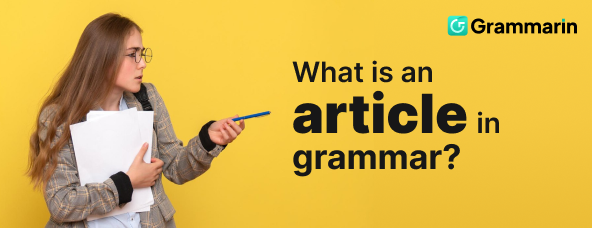What is an Article in Grammar? Definition, Types & Examples
It is easy to overlook some of the simplest elements of the English language that hold everything together. One such element is the article. It is a small but essential part of sentences. An article defines whether we are talking about something specific or more general. It shapes the meaning of nouns and helps clarify what we refer to.
Articles might feel natural to English speakers, but the rules can be tricky for newbies. Many languages don’t even use articles at all. And that’s why learning their correct usage can significantly improve your ability to express ideas clearly.

In this blog, we will discuss this important part of speech along with its different types. Moreover, we will explore how it is used with other elements of language.
Definition of Article
According to Merriam-Webster, an article is “any of a small set of words or affixes (such as a, an, and the) used with nouns to limit or give definiteness to the application.”
In English grammar, an article is a word that comes before a noun to determine whether the noun is specific or general. In simpler terms, articles tell us if we are referring to something definite (Unique like the sun) or indefinite (one of many possible things like a chair).
Types of Articles
Articles in English are divided into two categories: definite and indefinite. Each type has its role in clarifying the meaning of a noun. Let’s take a closer look at how they work.
Definite Article
The word “the” is the definite article in grammar. When we use “the,” we refer to something specific that the listener or reader already knows. For example, if you say, “the car is parked outside,” you are talking about a particular car. The person you are speaking to knows precisely which car is referred to. This article singles out one thing from a group or crowd.
Some examples of definite articles are given below.
- Please hand me the keys, I am in a bit of a hurry.
- The dog barked all night and kept us awake.
- Can’t you see I am trying to put the shoes on?
Indefinite Articles
On the other hand, “a” and “an” are indefinite articles in English. These articles are used when discussing something that has not been specifically identified yet. If you say, “I saw a bird,” you are not pointing to a particular bird. It could be any bird; the listener doesn’t need to know exactly which one.
The difference between “a” and “an” is simple. “a” is used before words that start with a consonant sound, and “an” is used before words that start with a vowel sound.
For example, we say, “a cat,” but “an apple
- She wants to buy a new car for her mother.
- I had an apple for breakfast.
- Can you recommend an interesting book?
Not every noun starting with a vowel alphabet will precede the article ‘an’. But they use ‘a’ instead of ‘an’ like university, unique, uniform, unit, utensil, eucalyptus, UFO, etc.
- She came up with a unique way to keep the insects away.
- George is crooked up. Today, he claimed that he saw a UFO last night.
- He grew a eucalyptus tree in the garden without knowing its impact. Now, his garden is ruined.
Sometimes, words starting with a consonant use the article ‘an’ instead of ‘a’. This rule only applies to words that start with a vowel sound like hour, honor, X-ray, MBA, etc.
- He gets an hourly wage for working in a restaurant.
- They applied for an MBBS degree this year.
- It was an honor to meet the Queen in person.
Usage of Article
The usage of articles often depends on some words that come before or after the noun. Here is a breakdown of how to use articles in various scenarios.
With Pronoun
Articles are not used with possessive pronouns. Words like my, his, her, its, our, and their; are used to identify the specificity of things like articles. However, if both possessive pronouns and articles are used together, the context will be confusing and vague. You can find out in the example below.
Incorrect: Why are you sitting in the her room without permission?
‘The’ and ‘her’ should not be used together because both have the same purpose; identifying a noun. You can choose one of them depending on the meaning.
Correct: Why are you sitting in the room without permission?
Correct: Why are you sitting in her room without permission?
With Uncountable Nouns
Uncountable nouns are impossible to count and they have the same singular and plural form. It comprises a collection of things or homogeneous substances. They are primarily written in a singular form because they cannot be separated.
The articles “a” & “an” are not used with uncountable nouns because they refer to things that cannot be counted or divided. They are used with adjectives like “some,” “few,” and “little.”
Let’s consider some examples for reference.
Incorrect: Please give me a milk.
Correct: Please give me some milk.
Correct: Please give me a glass of milk.
Milk is an uncountable noun and should not be used with the indefinite article. But, if you define milk as a countable unit (like a glass), you can use the indefinite article to modify it.
Here is another example:
Incorrect: Can you cook a rice for me?
Correct: Can you cook a bowl of rice for me?
Correct: Can you cook some rice for me?
Remember, some nouns can be both countable and uncountable simultaneously. In this situation, you can use the article according to the situation. Such nouns include time, gear, art, hair, light, etc.
Correct: She found a hair in the food at the Diner.
Correct: My sister has brunette hair but I am blonde.
With Adjectives
The word order for a sentence is article + adjective + noun, for example, “a yellow flower.” Here the article is modifying the noun which is specified by the adjective. You have to follow one rule for using an article before the adjective. If an indefinite article is required, it will be used according to the word that is used right after. Definite articles can be used as it is.
For example:
- She was wearing a lovely outfit at the party.
- Look what I have got! An ugly costume for Halloween.
These examples show that the word before the noun decides which indefinite article will be used.
With Idiomatic Expressions
Articles often behave differently when they appear in idiomatic expressions or phrases where the usual grammar rules don’t always apply. These expressions are fixed parts of the language. They are used without changing the structure, even if they seem to break the rules.
For example, in the expression “in a hurry,” the indefinite article “a” is used. But the phrase doesn’t refer to a specific hurry; it is just the way the idiom works. Similarly, in “on the whole,” the definite article “the” appears, yet we are not discussing a particular whole. The articles in idiomatic expressions often don’t follow the same logic as regular sentences.
Here are a few more examples:
- In the end (meaning finally)
- At a loss (meaning unsure)
- By the way (meaning incidentally)
Omission of Article
While articles are common in English, there are certain cases where they are omitted altogether. Articles are omitted when we talk about plural nouns in general. For instance, we say, “Dogs are loyal,” but we don’t say, “The dogs are loyal” unless we mean a specific group of dogs.
Moreover, articles are left out in headlines, titles, and instructions for brevity and clarity, like:
- President visits new city
- Take cake out of oven
Other instances of leaving the article are in case of mentioning nationality, sports, or a school subject. For example:
Incorrect: I never knew she is the Spanish.
Correct: I never knew she is Spanish.
Incorrect: He has been playing the football since he was a kid.
Correct: He has been playing football since he was a kid.
Incorrect: She took the math and the Geology in her high school.
Correct: She took math and Geology in her high school.
Wrap Up
The role of articles in English grammar seems small. But it has a big impact on how we communicate. Choosing between ‘the’ for something specific or “a/an” for something general gives us clarity in our speech and writing. They even pop up in idiomatic expressions and must be left out in certain situations, like with uncountable nouns.
By learning the rules and exceptions, you’ll improve your grammar and gain confidence in your English communication skills. After all, these little words play a big part in helping us express ourselves accurately and effectively. Still if you face any type of grammar related issues, run a grammar check test to fix all the grammar related issues in seconds.


